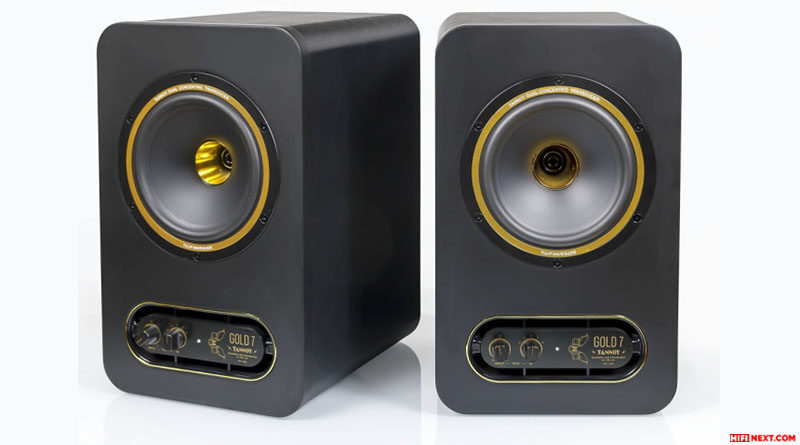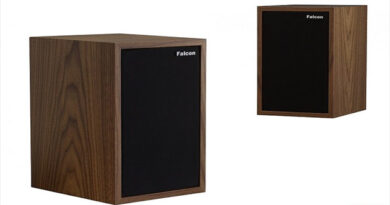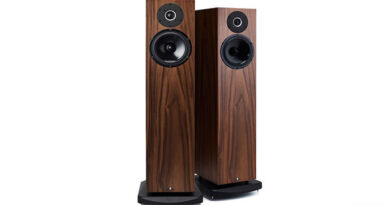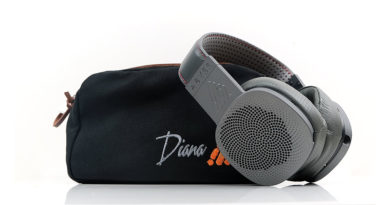Tannoy Gold 7 Review: New Series Active Monitors with Dual Concentric Coaxial Emitters
The Tannoy Gold series of monitors are available in three models. They are all two-way, near-field and have Dual Concentric coaxial speakers. The differences lie in the size of the speakers and the power of the amplifier. The number in the model name indicates the diameter of the woofer used. We tested the 7-inch Tannoy Gold 7 monitors, which sit in the middle between the massive Gold 8 and the compact Gold 5.
Tannoy introduced its legendary Dual Concentric coaxial speakers back in 1947. Their key feature is the special combined tweeter and woofer design, with a dual horn. The outstanding sounding of those times immediately attracted public attention and made the loudspeakers iconic. For decades, many of the leading recording studios have operated monitors based on Tannoy coaxial drivers. Interestingly, the design of the current Dual Concentric speakers remains largely unchanged. And although the manufacturer is constantly improving them, using new materials, advanced means of production and modern research, the concept remains unchanged.
The most widely used emitters Dual Concentric received in Hi-Fi and High-End direction. In Tannoy studio loudspeakers, coaxial speakers were used less frequently, as two-way split speaker systems were easier to manufacture. The new Gold Series brings the legendary Dual Concentric technology back to the mainstream Tannoy active monitors.
Gold monitors look impressive. The gold-tone coaxial tweeters give the appearance a recognizable appearance, just like the high-end passive Tannoy Hi-End speakers. The bass reflex port is unusually decorated with a control panel. Monitor cases are made of MDF, laminated with vinyl film.
Contents:
Features
Let’s take a look at what makes this unique coaxial speaker design special and what it does for sound. The main advantage of coaxial speaker placement over conventional two-way systems is a more coaxial and focused sound and a more uniform radiation pattern. In the coaxial emitter familiar to many, the tweeter is usually located in front of the woofer. In this case, only the alignment of the emitters is respected, which saves space when designing the column case.

In the Dual Concentric design, the dome tweeter is located deep inside, behind the woofer magnet system. This arrangement of the tweeter allows the use of a unique elongated horn design. It takes its origin from the membrane of the tweeter, continues inside the magnetic system of the woofer and smoothly passes into the woofer cone, which, with its profiled cone shape, continues the horn design of the tweeter. That is, the horn system consists of two parts. It is for this reason that Tannoy coaxial speakers are called Dual Concentric.

Since the horn has a certain geometry, resonances in a narrow frequency range can form inside it. To eliminate such shortcomings, there are additional cylinders of different diameters and profiles inside the horn, which allow removing the “megaphone effect” and making the frequency response even. The proprietary design of waveguides inside the horn resembles a tulip flower, so the manufacturer called this technology Tannoy HF Tulip Waveguide and received a patent for its invention.

According to the manufacturer, the Dual Concentric design achieves low phase distortion and uniform radiation pattern. For studio acoustics, directionality is less critical than for home acoustics, since its use already implies the correct placement of monitors aimed strictly at one listener. It is more important that the monitors sound more informative, balanced and even.
The diaphragm of the tweeter itself is made of titanium. In the model under consideration, the diameter of the radiator is 25.4 mm, as in the older eight-inch model. The youngest Gold 5 monitors have a slightly smaller membrane, 20 mm. The woofer cone is made of polymer material, its suspension size is 13.5 cm. The crossover in the Gold 7 operates at a frequency of 1.5 kHz.
The acoustic design of the Gold series monitors is a bass reflex circuit. The FI port is led forward, which allows the use of monitors in the immediate vicinity of the wall.

At the output of the bass reflex there is a control panel that allows you to adjust the sensitivity of the input equalization at high frequencies. The sensitivity is infinitely adjustable in the range from -24 dB to 0 dB. Treble adjustment is fixed within ± 2 dB. In addition, a power LED is brought forward, which lights up green in operation mode and red in power saving mode.

Monitors are connected both through a balanced connection, via TRS and XLR connectors, and unbalanced, through a minijack connector. When connecting via a minijack, the second speaker must be connected to the first additional wire, which is included in the kit. And using the switch, select the channel corresponding to the location of the monitors. The rear of the monitor also includes low frequency suppression and power saving deactivation.

I am very impressed that the power amplifier of the Gold monitors is designed in class A / B. More and more modern active acoustics are equipped with class D amplifiers, which, in our opinion, does not always benefit the sound quality, especially in inexpensive models.
The Gold 7 monitor amplifier is based on two powerful TDA7293 microcircuits traditionally used in studio acoustics amplifiers. Their rated power values are 70 W at a supply voltage of ± 29V and less than 0.1% distortion. This is more than enough for near-field monitors.
Frequency response measurements
The measurements are performed using the RightMark ™ Audio Analyzer PRO software and hardware complex. The measuring microphone Earthworks M50 is also used, with passport data:
- serial number: 9291C
- sensitivity at 1 kHz: 26.4mV/Pa
- uneven frequency response in the range of 20 Hz – 20 kHz: 0.2 dB
- uneven frequency response in the range of 3 Hz – 50 kHz: + 1 / −3 dB (roll-off from 45 kHz)

on the speaker axis
The frequency response of the Tannoy Gold 7 monitors looks pretty flat. In the working area, the unevenness does not exceed ± 3 dB. The exception is the uppermost range, where there is a small spike above 10 kHz. The low-frequency range of monitors confidently starts from 50 Hz, which is a very good result for a seven-inch acoustics.

in different positions of the TRIM HF regulator
The high frequencies are adjusted within the stated range of ± 2 dB at frequencies from 1 kHz and above.

in different positions of the BASS ADJUST control
The BASS ADJUST setting allows you to reduce the saturation of low frequencies when using the monitors in an acoustically unprepared room. On measurements, you can clearly see that suppression is performed from 200 Hz and below by -2 dB and -4 dB.
Sound
When looking at the unusual design of coaxial speakers, one might think that the Gold 7 sounds something completely different or has a specific color. In reality, Tannoy Gold 7 monitors have a traditional sound character. In addition to this, the focus and integrity of the sound is best heard in them. This is most evident in the midrange, which is the best for the Tannoy Gold 7. Good detail and fusion allows you to accurately hear all the nuances of spatial processing and movement of sources when panning, and good transient characteristics of the woofer contribute to the formation of a clear and clear attack.
From our own experience, we know that one of the most difficult tasks for a seven-inch acoustics is timbre accuracy and sound neutrality. Usually, a large woofer plays the upper mids not as well as in five-inch speakers, and the lower mids are not yet as full-fledged as in eight-inch speakers. In this respect, Tannoy Gold 7 monitors break stereotypes and look convincing. Their sound is closer to 8 “monitors, with a predominance of intelligibility in the lower middle, but the upper midrange does not fail in timbre. This allows you to work fully with sound in the entire midrange, whether it is equalization or matching different timbres in the mix.
As for the directionality of sound from the use of horn design, this is practically not felt in the Tannoy Gold 7 monitors. At least in the near field, if positioned correctly, there are no dips. If you do not deviate strongly from the axis of the speakers, then the saturation at the treble is stable. In this respect, the directionality of Tannoy monitors is no different from split speaker speakers.
The work of the lower case should also be noted. There is no shortage of the bottom in Tannoy Gold 7. The monitors provide good control of the low-frequency range by capturing the lowest notes informatively. Judging by the measurements, the bass reflex port is tuned to frequencies around 50 Hz. The phase inverter gives good sound to the lowest range, without audible artifacts. No booming or resonant howling is heard. In our conditions of use, we even had to reduce the saturation using the control on the rear panel.
In terms of sound quality, the monitors turned out to be successful in all respects. As a matter of fact, we would like to hear a little more detail in the high-frequency region in the Tannoy Gold 7. Perhaps this is the only moment that we managed to find fault with. Treble looks quite balanced against the general background and remains legible at different volume levels. But for complete happiness, they lack a little detail.
Conclusions
Overall, the Tannoy Gold 7 monitors have made a positive impression and deserve consideration when choosing active monitors for both the studio and for listening to music on a PC. They look impressive and sound good. Tannoy Gold is more expensive than entry-level studio loudspeakers, but it also performs significantly better than them.
As for the use of the coaxial speaker structure in monitors, it does not impart any special specificity to the sound and does not limit their scope. The Tannoy Gold 7 monitors, without any reservations, have a professional sound solution for a wide variety of studio needs. It’s nice to see more and more decent active monitors on the market.
Tannoy Gold 7 specs
- Powered: Yes
- Power Configuration: Bi-amped
- LF Driver Size: 6.5″
- HF Driver Size: 1″ Tweeter
- HF Driver Type: Titanium
- Total Power: 300W Class-AB
- Frequency Response: 65 Hz – 20 kHz ±3 dB
- Crossover Frequency: 1.5 kHz
- Maximum Peak SPL: 110 dB SPL @ 1m
- Input Types: 1 x 1/4″, 1 x XLR, 1 x 1/8″ (aux)
- Output Types: 1 x 1/8″ (monitor link)
- Enclosure Type: Front Ported
- Enclosure Material: MDF with Black Vinyl wrap
- Height: 14″
- Width: 8.7″
- Depth: 11.3″
- Weight: 20.7 lbs.
- Manufacturer Part Number: 000-CMZ02-00010




